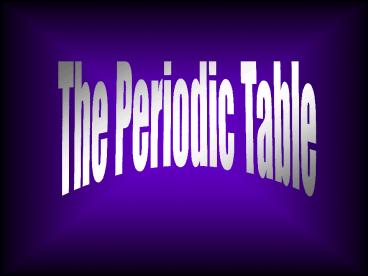The Periodic Table - PowerPoint PPT Presentation
Title:
The Periodic Table
Description:
* * * * * * * * * * * The modern periodic table Elements arranged in order of increasing atomic number. Arranged in groups and periods. Elements are arranged ... – PowerPoint PPT presentation
Number of Views:159
Avg rating:3.0/5.0
Title: The Periodic Table
1
The Periodic Table
2
The modern periodic table
- Elements arranged in order of increasing atomic
number. - Arranged in groups and periods.
3
(No Transcript)
4
Elements are arranged
5
If you looked at one atom of every element in a
group you would see
6
Each atom has the same number of electrons in
its outermost shell.
- An example
7
Each atom has the same number of electrons in
its outermost shell.
Be (Beryllium) Atom
Mg (Magnesium) Atom
8
If you looked at an atom from each element in a
period
you would see
9
Each atom has the same number of electron holding
shells.
An example
10
period 4 atoms each have 4 electron containing
shells
4th Shell
K (Potassium) Atom
Kr (Krypton) Atom
Fe (Iron) Atom
11
Each group has distinct properties
- The periodic Table is divided into several groups
based on the properties of different atoms.
12
Alkali Metals Soft, silvery colored metals,
conduct electricity Very reactive!!! Especially
with water
13
Alkaline Earth Metals
Silvery-White Metals Malleable Fairly
reactive Many are found in rocks in the earths
crust Conduct electricity
14
Transition Metals
Malleable (easily bent/hammered into wires or
sheets)
Most are good Conductors of electricity
15
Metalloids lie on either side of these
stairsteps
They share properties with both metals and
non-metals Si (Silicon) and Ge (Germanium) are
very important semi-conductors
16
Nonmetals
Brittle Do not conduct electricity
17
Halogens
Most are Poisonous Fairly reactive Fluorine is
the most reactive element - It can combine with
nearly any element on Earth.
18
Noble Gases
Unreactive Gases at room temperature
19
Lanthanide Series
Actinide Series
20
(No Transcript)
21
Things I need to know
- Metals are solid, shiny malleable and ductile,
and conduct electricity. - Nonmetals are liquid or gas, dull, brittle, and
do not conduct electricity. - Metalloids are solid, dull, brittle, and are
semiconductors.
22
(No Transcript)
23
(No Transcript)































